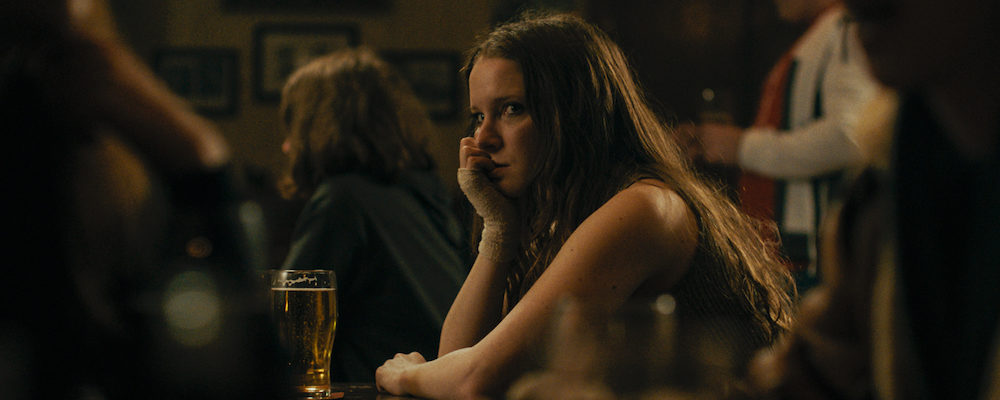‘Saint Maud’ Summons Unnerving Atmosphere With Empty Faith
Alci Rengifo
After endless delays we can finally take a look at “Saint Maud.” Originally slated for a 2020 release, this debut by director Rose Glass was yet another movie forced to continuously push back due to the Covid-19 pandemic. Now it is receiving a limited theatrical run before releasing on Epix Feb. 12. Dripping with mostly a lot of atmosphere, this is the kind of movie that perfectly defines what should be called postmodern horror. What this means is that style overtakes substance and its symbols, some very on the nose, overtake a richer sense of story. But it can’t be denied that Glass announces herself as a filmmaker worth following, with a command of memorable images.
The setting is an Irish seaside town constantly under gloomy skies. Maud (Morfydd Clark) is an introverted in-home nurse hired to care for Amanda (Jennifer Ehle), who suffers from stage-four lymphoma of the spine. On the surface Maud seems like a very sweet person, but in private she’s a quietly zealous Roman Catholic, constantly chatting with the almighty and even praying while pressing her knees against sharp objects. It also becomes apparent that Maud is a bit turned off by Amanda’s own lifestyle, or what’s left of it. Amanda is a former professional dancer, which means she invites bohemian types to the house and has lesbian sex. Maud sees herself as on a mission to save Amanda’s soul and at first subtly, then openly, let’s her patient know she needs God. All the while she is having intensifying (though repetitive) visions, and when Amanda doesn’t seem like she’s budging, Maud might just go on a holy rampage.
Until now Glass has mostly been a director of eerie short films. With “Saint Maud” she delivers a feature that doesn’t run too long and feels safer hiding any attempts at broader writing with sharp gothic images. It never becomes a slog or overly pretentious like “The Lodge” or other “Hereditary” wannabes. It has more in common with recent eerie indies like “The Other Lamb,” where the cinematography is the real star while the narrative stays surprisingly bare. Essentially Glass is borrowing from countless other scary movies where religion is the easy go-to. Maud thinks she’s God’s agent. How or why is never really explored. Oddly enough, for someone so pious we never see Maud ever go to church. She has saints on her wall and a crucifix that whispers to her like the satanic goat Black Phillip in “The Witch,” but she never even opens a Bible. You would think Maud would know by heart chapters and verses. It’s a superficial use of the subject matter and so Maud as a diehard fanatic is rarely convincing. Then again it might work with audience members who know little of religion or have never met an actual zealot. Amanda gifts Maud a copy of William Blake’s work, which feels like an excuse to have a few close-ups of Blake’s timeless mystical artwork.
Glass is clearly trying to make some kind of statement about how religious extremists don’t approve of liberal or secular culture. Maud tries to get Amanda’s lesbian friend Carol (Lily Frazer) to stay away from the house, and when Amanda has a few friends over, all dressed like cliché West Hollywood denizens, she pokes fun at Maud for “being my savior.” Thus the party guests taunt the nurse as “Saint Maud.” Yet it’s the most Glass can do to explore the conflict at what should be the deeper level of the story. We know hyper conservatives like Maud exist, but what makes her tick? Where does this piety come from? After the party she goes on a kind of sin binge, hanging out at bars, randomly jerking off one guy and then sleeping with another. Was this her old lifestyle before becoming so devoted to faith? It’s up to us to fill in the blanks, as is the case with most postmodern horror. An effectively unnerving opening scene and later flashback hint Maud was let go of another job after a tragedy involving another patient. But just what happened, we never find out. Unless Glass is saving all that for “Saint Maud II: Resurrection.”
Where the movie does work is purely in its images and performances. Jennifer Ehle, lit in Caravaggio shadows, emits a sober acceptance of death, and even pity for Maud. Morfydd Clark has an unsettling anxiety, capturing perfectly the tone of the true believer feeling out of place in a sinful world. They have individual moments that would have greater power in a bolder narrative, like Amanda nonchalant telling Maud God is fiction, or Maud levitating alone in her apartment as in a divine grip, while fireworks explode outside her windows. There is a hint Maud is insane, which is brought home in ethereal shots that then contradict with reality, like Maud in her grungy apartment suddenly sprouting neon wings. Other memorable shots include hallucinations of swirling holes in cloudy skies and a final, fiery close-up that almost leaves no doubt Maud is a walking tragedy lost in delusion. Meanwhile the music by Adam Janota Bzowski copies the same scratchy string arrangement everyone’s been doing.
Dark religious impulses and cults have been in vogue a lot lately in indie horror, maybe because they speak to the recent phenomenon of vast swaths of people following maniacs and conspiracy theories. “Saint Maud” is more of a psychological puzzle with the look of a scary movie. There are not many boo moments, although the few Glass pulls off are decent jump-inducers. What works is the superficial sense of atmosphere, made palpable by good actors. But looks can only go so far. After a while the movie feels like it’s announcing a good director who is still gearing up to deliver an even better sermon.
“Saint Maud” releases Jan. 29 in select cities and premieres Feb. 12 on Epix.

